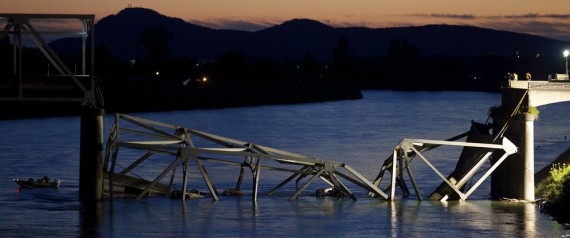Our
aging infrastructure earned a D+ overall in the American Society of
Civil Engineers' annual report card. Here are the main culprits.
The World Economic Forum's Global Competitiveness Report for 2013-2014 ranked the United States a respectable No. 5 in term of overall competitiveness. But our prospects for the future are clouded by an infrastructure ranking that barely cracks the top 20.
On multiple ratings, the U.S. came out on top in exactly one category: the availability of airline travel. Other than that, rankings on the quality of roads (18th), rail (17th), ports (16th) and other measures show it trailing many of its international competitors.
Earlier this year, the American Society of Civil Engineers issued its annual infrastructure report card, and awarded the U.S. a D+ for infrastructure. You can discount the ASCE's findings as you please, considering the fact that civil engineers, as a whole, benefit from increased infrastructure spending, but the numbers are hard to argue with.
A few highlights from the report:
- One in four bridges in the U.S. today are either structurally deficient, meaning that their condition has deteriorated to the point that they require annual safety inspections to remain open, or functionally obsolete, which means that they were built to such a low standard that they would be illegal to build today.
- "Almost half of America's public school buildings were built to educate the baby boomers – a generation that is now retiring from the workforce," the report found. Meanwhile, annual spending on school construction fell to $10 billion in 2012, down 50 percent from pre-recession levels.
- Congestion alone on U.S. highways costs the economy $101 billion in fuel and lost productivity every year.
Read More Here
.....
Where's The Moral Outrage' Over Daily Disaster Of America's Bridges, Experts Ask
Posted: 01/15/2014 8:18 pm EST | Updated: 01/25/2014 4:01 pm EST
Eugene Mulero
eugene.mulero@huffingtonpost.com
The scene of a bridge collapse on Interstate 5 on May 23, 2013, near
Mt. Vernon, Wash. The interstate connects Seattle to Vancouver, B.C.,
Canada.
| Stephen Brashear via Getty Images
WASHINGTON -- Bridgegate has been a nightmare for New Jersey Gov.
Chris Christie (R), but it could have one upside for the rest of
America: The scandal has refocused desperately needed attention on the
New York metropolitan area's traffic bottlenecks and, more generally,
the perilous state of America's bridges.For years, leading transportation experts have been sounding the alarm over the country's aging infrastructure, warning that many bridges -- primarily those built during or before the Eisenhower administration -- struggle to handle today's traffic demands.
The George Washington Bridge at the center of the Christie scandal is not on the most endangered list, although it is undergoing some major work. But the American Society of Civil Engineers (ASCE) has identified thousands of other bridges in poor condition that could present dangers to commuters.
In recent years, two highway bridges have actually collapsed. A bridge along Interstate 5 in Washington state failed in 2013 after it was struck by a truck. No fatalities were reported, but traffic between Seattle and Vancouver was redirected for nearly four months. In 2007, a bridge along Interstate 35 in Minnesota collapsed, killing 13 people. It was more than a year before a new bridge opened.
The state of New Jersey, Christie's domain, has 6,554 bridges in all, and 651 of them are considered structurally deficient -- meaning they are either deteriorating or severely damaged. More than one-quarter of them are considered functionally obsolete, meaning they no longer meet current standards, according to the ASCE. In New York state, 2,168 bridges out of 17,420 have been found to be structurally deficient, and 4,718 bridges are functionally obsolete.
The ASCE estimates that more than 200 million trips are taken across structurally deficient or functionally obsolete bridges every day in 102 metropolitan regions nationwide. One in nine of the nation’s 607,380 bridges are rated as structurally deficient, while the average age of bridges nationwide is 42 years, according to an analysis by the ASCE. In its authoritative report card for 2013, the group gave the country's bridges an overall C+ grade.
Read More Here
.....










